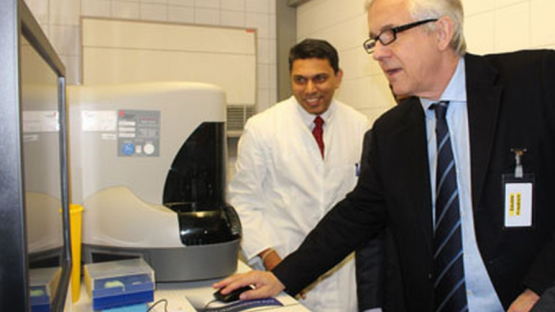
If you would like to learn more about the IAEA’s work, sign up for our weekly updates containing our most important news, multimedia and more.
Improving Vaccine Efficiency to Fight Livestock Diseases with New Flow-Cytometer
Seibersdorf, 14 October 2015. Vaccines protect livestock against animal diseases and are crucial in disease control programs. Before novel vaccines are released to the market, they undergo a long and complex development, testing and approval process. A new state-of-the-art piece of equipment, a flow-cytometer, has been provided by the Government of Germany to the Animal Production and Health Laboratory in Seibersdorf. This new equipment will enable the laboratory to better investigate immune responses induced by such vaccines and provide better insights on their potential.
"Vaccines are the most cost effective tools in preventing animal diseases," explained Viskam Wijewardana, Animal Health Officer in the laboratory that is part of the Joint FAO/IAEA Division of Nuclear Techniques in Food and Agriculture. "Designing and developing effective vaccines for unmet needs is therefore a priority in the laboratory".
The most crucial phases of vaccine development are the exploratory and pre-clinical stages. In these stages, the researchers aim to understand the disease in itself to develop vaccines with a high efficiency. The flow cytometer helps elucidate the hosts' immune cells involved and their responses to a disease-causing pathogen. As a result, better vaccines and immune stimulators can be designed. Furthermore, transferring the technology to Member State laboratories will expand the research base for understanding the immunology of emerging and re-emerging diseases and their prevention.
The new equipment is an in-kind contribution by the Government of Germany to the modernization project called "Renovation of the Nuclear Applications Laboratories" (ReNuAL) in Seibersdorf. The German Ambassador, His Excellency Mr. Friedrich Däuble, symbolically switched on the flow cytometer when visiting the Seibersdorf laboratory this week.
The new equipment will enable scientists to better understand and fight two devastating livestock diseases, for which no vaccines exist at present: African Swine Fever and Trypanosomosis.
"Our research has shown that irradiating pathogens to a specific level will lead to a metabolically active yet not multiplying germ, which could be used to induce immunity in the host. With this new equipment we can much better analyze the host immune response and thus improve the designing of vaccines," explained Mr, Wijewardana. "The training of scientists from Member States and the transfer of the technology is already planned, for instance, for experiments on African Swine Fever. These scientists are actively involved in the development of cellular immunology technologies," he added.

